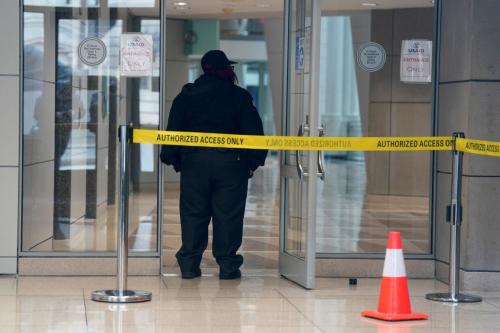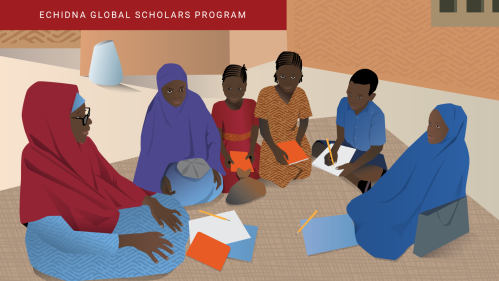President Obama pledged to “seek a new beginning between the United States and Muslims around the world” in his highly anticipated speech in Cairo. In addition to signaling important shifts in America’s approach to political challenges, such as the Arab-Israeli conflict, he also signaled a new path for supporting crucial social and economic development for millions of Muslims around the world. Recognizing that education is central to any long-term progress in the 21st century, he promised to partner with “any Muslim-majority country” to improve girls’ literacy and women’s employment.
This is a welcomed promise. The focus on supporting “any Muslim-majority country,” not just those of particular geo-political interest to the U.S., to improve the chronically underfunded area of education is an important step toward improving U.S.-Muslim relations today and especially in the future. Investing in education, particularly for women and girls, is one of the smartest investments the president can make if he is serious about working with Muslim communities to improve their quality of life. Educating women and girls has one of the highest rates of returns in terms of development outcomes and has been proven to improve economic productivity, lower infant and maternal mortality, and prevent HIV/AIDS. Many countries in the Muslim world are eager to see increased gender equality in education. Public opinion polls in Egypt, Jordan, Lebanon, and Morocco show that 98 percent of the population support equal access to education for girls and boys.
The Muslim world is diverse and subjected to multiple definitions—most notably, it is defined as the member countries of the Organization of Islamic Conference (OIC), which includes 57 countries spanning four continents. Despite the heterogeneity across and within these countries, there are four elements important to developing an effective education strategy for the Muslim World.
Inclusion
Many countries across the Muslim world are characterized by patterns of educational exclusion. Girls are less likely to have access to education than boys, rural children are less likely to be educated than those living in urban areas, and older children and youth have much fewer educational options than young children. For example, in Egypt 96 percent of the 232,000 children not in primary school are girls. According to UNESCO, Arab States, of all the regions in the world, have the highest percentage of primary-age girls not enrolled in school. In Pakistan, rural girls and boys are enrolled in primary school at much lower rates than their urban peers. In the province of Baluchistan, for example, 85 percent of girls in urban areas attend school while only 40 percent in rural areas attend. In many countries, such as Cote d’Ivoire, girls and boys who have missed years of education or start late are “aged-out” of school, leaving them with few, if any, options for learning essential literacy, numeracy and critical thinking skills. Illiterate young people and adults have even fewer choices for improving their knowledge-base and skills. Across the OIC countries, 293.9 million people aged 15 and above are illiterate, the majority being women. Any sound education policy for the Muslim world will need to ensure that educational investments address patterns of exclusion across not only gender but also location and age.
Quality
For those who are able to access education, the quality is often low. Poorly trained teachers, over-crowded classrooms, and a dearth of learning materials are common problems hindering students from learning. In many countries in the Muslim world, students have to repeat years of schooling because of the poor quality of education services. UNESCO estimates that 4 percent of all students in primary school in the Arab region repeat a grade. Interestingly, although they have less access to school, girls appear to be better students than boys—only 3.3 percent of girls repeat classes whereas 4.6 percent of boys do. Improving the quality of the education provided is essential to not only ensuring that students are actually learning the key skills they need but especially to ensuring parents keep their girls in school.
Relevance
Any effective educational strategy for the Muslim world needs to ensure that children, youth and adults are acquiring the relevant skills and knowledge needed to improve their lives. To do this, multiple learning pathways are needed. Too often educational investments focus on formal schooling and not on other alternatives such as the winning combination of technical training, functional literacy and numeracy, and business skills development—all of which should be closely linked to labor market demands. The majority of the 1.5 billion people in the Muslim world (835.7 million) are under the age of 24 and many are unemployed. In the Middle East, 25 percent of youth are unemployed. While formal school credentials are often highly valued by youth, their acquisition do not always help with productive employment. In Egypt, adults with a secondary school education account for 42 percent of the population but 80 percent of the unemployed, indicating a crucial need to review many aspects of the education system, especially school curricula.
Conflict-sensitivity
Unfortunately, the presence or significant threat of armed conflict is relatively common in the Muslim world and faced by two out of three countries. This has profound implications for how to approach educational investment. Not only must any effective educational strategy contend with displaced populations, disrupted schooling, and unsafe learning environments, it must also be acutely sensitive to the political nature of education itself. More than any other sector, a country’s education system is tool for influencing and in some cases creating national identity. Who can access education, in what language, and what is taught are all aspects of any given education system that can be manipulated to either promote divisiveness, oppression, and exclusion—common drivers of armed conflict—or to mitigate them. For example, under Saddam Hussein, the Iraqi education curriculum heavily promoted the Ba’ath party, a legacy the country is still struggling to sort out. Conflict-analysis, which is rarely done in relation to education, should be part of any design and implementation of educational interventions in the Muslim world.
To begin a new relationship with the Muslim world, President Obama must fulfill the promises he made in Cairo on June 4, 2009. He should partner with the Muslim world to develop a concrete and effective education strategy, one that is well-funded, seeks to support countries based on need, advances stability and peace, and promotes the long-term development of children, youth and adults.
Sources
UNESCO Global Monitoring Report (2009); UNDP Arab Human Development Report (2005); UNICEF Investing in the Children of the Islamic World (2005); World Bank, Investing in All People: Educating Women in Developing Countries (1994); Brookings Institution, Change We Can Believe In? The Muslim World, America, and Obama’s Promise (2009); Brookings Institution Ending Poverty, Promoting Peace: The Quest for Global Security (2006).
The Brookings Institution is committed to quality, independence, and impact.
We are supported by a diverse array of funders. In line with our values and policies, each Brookings publication represents the sole views of its author(s).



Commentary
Op-edObama’s Education Promise for the Muslim World—Rhetoric or Reality?
June 5, 2009